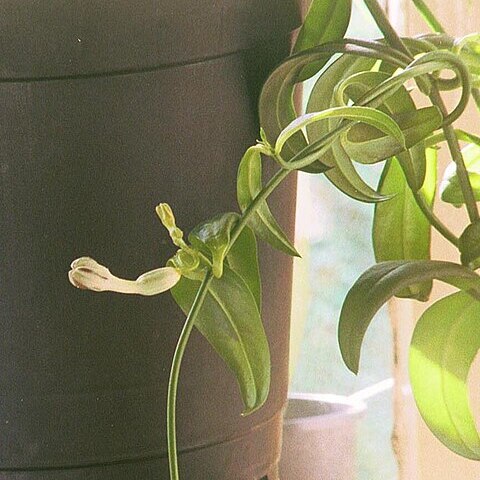Twining, subsucculent geophyte. Stem solitary, produced annually from fascicled rootstock, somewhat succulent, up to 3 m high in northern provinces. Leaves linear or linear-lanceolate and folded, up to 100 x 45 mm, base occasionally asymmetric, apex apiculate, margins irregularly crispate. Flowers (2)3-7 in contracted cymes; peduncles 5-30 mm long; pedicels 4.5-6.5 mm long. Corolla cylindrically urceolate, 25-50 mm long; tube straight or slightly curved, 16-34 mm long with a globose basal inflation 5-9 mm in diam., inflated at mouth; lobes broadly oblong to narrowly lanceolate, 9.0-13.5 x 3.0-4.5 mm, margins strongly folded back and apically connivent, forming a cap-like or rounded cage over mouth; colour variable, tube pale green with purple markings, striped inside, inner surface of lobes with purple-brown reticulations and long purple hairs at base. Corona: interstaminal corona lobes dorso-ventrally flattened and erect, connate to each other and adnate to staminal corona to create 1.5-2.8 mm deep, fluted pockets, level or just overtopping style-stigma-head; staminal corona lobes fused basally to interstaminal corona, incumbent on anther backs and connivent over style-stigma-head.
Succulent climbing or twining perennial herb. Leaves decreasing in size. Flowers in dense cymes. Corolla 25-50 mm long, ± a third divided, with basal inflation globose. Flowers pale green with purplish markings and purplish blotched and striped inside; inner surface of lobes closely reticulate with purple-brown, with long purple hairs in base of keel.
A vine. It has thick leaves. It is a succulent plant. It keeps growing from year to year with annual stems from the rootstock. It has a cluster of long fleshy roots. It grows about 1 m high. The leaves are simple and sword shaped. The flowers are green or cream. They are cup shaped.
Succulent climber to 1.5 m; sap clear. Leaves opposite, slightly fleshy, ovate-elliptic. Flowers 25-50 mm long, tube flaring above, pale green with purple bars and spots, petals keeled and ciliate.

